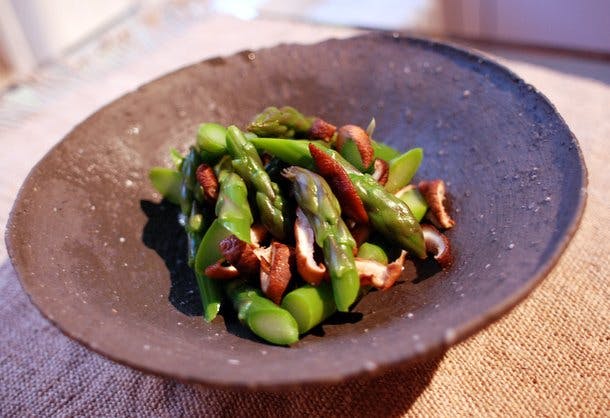
Layering Flavor into Vegetables
Learn about the traditional Japanese cooking technique of shita aji and how Chef Ryo from Matsuri restaurant prepares fiddlehead ferns using this method. Discover the use of konbu-katsuobushi dashi and usukuchi soy sauce in marinating the vegetables, and how to apply this technique to other ingredients like asparagus and shiitake. Dive into the delicate and flavorful world of Japanese cuisine.
During the staff meal break the other night at Matsuri, I noticed Chef Ryuji cleaning a pile of fiddlehead ferns. Ryo is the Chef du Cuisine at the restaurant. I love watching him in action -- this man knows how to cook. During the break I can usually find Ryo by himself behind the line, working on something in the remaining quiet moments before service -- and its attendant frenzy -- begins.
"Fiddleheads mean spring is here," Ryo said while rinsing them in water. While we think of these fleeting, curled ferns as native to New England, they're also prized in Japan, where they're called warabi. I was curious to see how he prepared them, Japanese-style.
"Vegetables are the most difficult ingredients to cook," Ryo explained. Meat has a powerful taste, but vegetables are much more delicate, of course. To bring out their flavors, he continued, Japanese cooks rely on a basic technique called shita aji, which I believe (correct me if I'm wrong!) literally means "underlying taste."
With this preparation, vegetables are poached briefly in boiling water, shocked in an ice bath, and then marinated in konbu-katsuobushi dashi with a touch of soy sauce. "We don't sauté vegetables with strong flavors like ginger and garlic," said Ryo. Instead, this marinade adds a subtle but sublime dimension to vegetables that fits the sensibility of Japanese cooking.
As I watched Ryo prepare the fiddleheads shita aji, I noticed him adding usukuchi soy sauce to dashi, a lighter-colored soy sauce from the Kansai region that wouldn't overwhelm the bright green color of the ferns. But how much soy sauce? I spooned a little taste from his mixing bowl. It was a bit salty but not overly so (keep in mind that usukuchi soy sauce is saltier than the usual, darker Japanese soy sauce, so use with care -- and taste often). Ryo marinated the fiddleheads for about 15 minutes.
I tried this at home with asparagus, which were delicious. In the picture above you'll see slices of shiitake mingling with the bright green stalks (the poaching and shocking really brightens the colors). I grilled the shiitake briefly in a dry cast iron pan to dehydrate them a bit and concentrate their flavors -- another one of Ryo's techniques. Thanks, Ryo!
